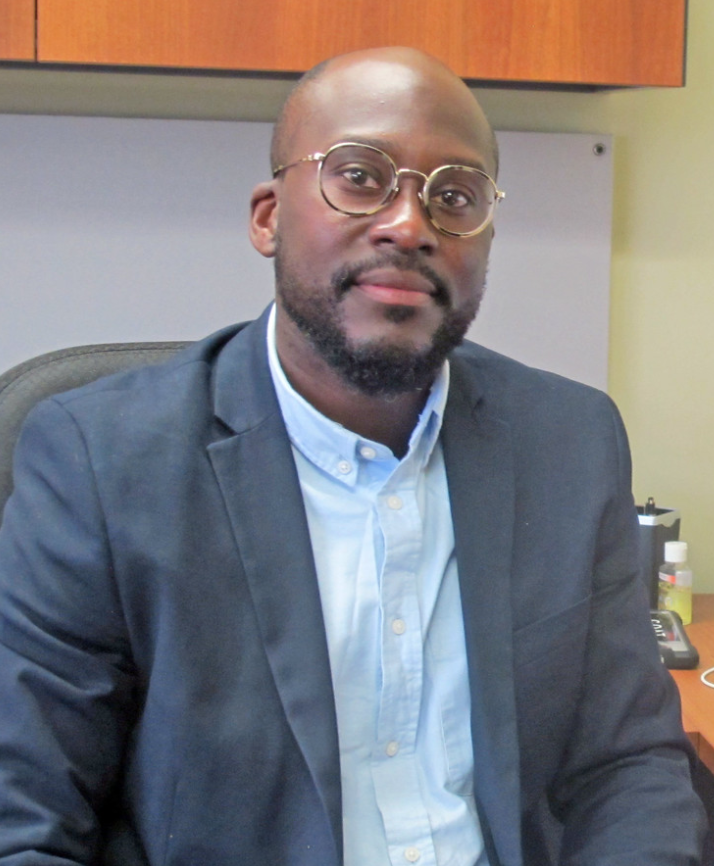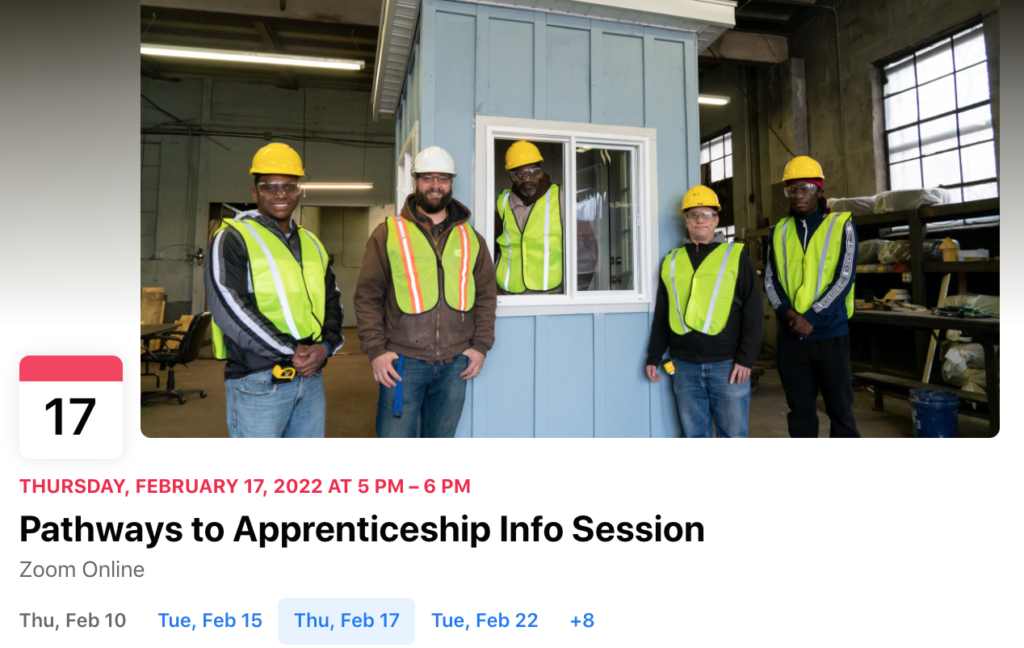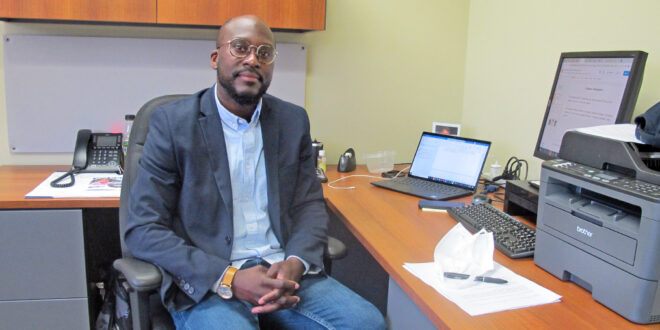How Syracuse Build’s new director Christopher Montgomery is mobilizing a local workforce
By Ashley Kang
The planned reconstruction of Interstate 81 will remake portions of the South Side as well as downtown, creating hundreds of jobs as soon as this year. Intentional efforts are underway to ensure local and minority workers are hired to fill these needs thanks to a collaborative effort by the city of Syracuse, Onondaga County, CenterState CEO and Central & Northern New York Building Trades Council.

Together these groups are united by the newly installed director of Syracuse Build, Christopher Montgomery, who shares that his very first job was actually in construction.
“Working for the family business — CC Paving & Excavating,” he said. “I started helping out at an early age and worked throughout high school and into college. It gave me knowledge of what construction entails, like, working in all weather conditions and being up at 6 a.m.”
A large component of the initiative includes the Syracuse Build’s Pathways to Apprenticeship program. This paid training aims to expand access to the building trades for women, minorities and veterans. Montgomery says he’s exploring ways to enhance it in the future by possibly offering two separate cohorts at once due to the demand he sees.
Applications to join the third cohort will be accepted until Feb. 24.
Q: First, give me the elevator pitch for Syracuse Build?
A. Syracuse Build is an initiative with the goal to build a robust and inclusive workforce pipeline to align upcoming employment opportunities in our area with local workers. Within Syracuse Build, we work to establish a suite of programs that can help cultivate a stronger quantity of qualified workers to meet workforce needs. It’s important for city residents, because it is intentional, and we want to see local folks hired to local projects.
Q. What is the course like?
A. It’s 11 weeks and uses Multi-Craft Core Curriculum (MC3). This is a standard unit, nationally recognized curriculum used in multiple pre-apprenticeship and apprenticeship programs. Syracuse Build did its research and chose this because it is championed by many.
The course includes classroom hours and field trips. Enrollees have a chance to get their CPR first aid and OSHA (Occupational Safety and Health Administration) training. They are offered an industry overview with visits from different unions that train in different areas. Then there are shadowing opportunities and/or going to the unions to see directly what specific areas are like.
Q. What are the next steps once a participant completes training?
A. For Cohort One, after their graduation there are a couple different things happening. Some have been invited to join the union or are already in a union. Some applied for union apprenticeship opportunities and are waiting for enrollment windows to open. But know there are ways for those folks to get to work, and they have gone to work with the prospective units that they want to work with while they’re waiting for their apprenticeship enrollment process. This is likely at an entry level position within that union and they won’t be formerly with the union yet, but they do have opportunities to work and go straight to work while they await the start of an apprenticeship.
Q. What positions are in greatest demand?
A. Right now, in construction: CDL drivers, carpenters, laborers and heavy mechanic and technician operators. Those are the four that were needed last week, especially CDL. Also, HVAC and building maintenance.

Q. How does your prior experience make you the best fit for this role?
A. Throughout my career, being looked at as you’re not ready for certain opportunities or this may not be the right fit for you … Being told that I couldn’t but still learning and being able to persevere, being able to accomplish, drew me into this career path. Now I’m able to advocate, but I’m also able to be empathetic. To let those we work with know, you can do this; these opportunities are for you.
On the other side of it, is having some great opportunities. The networks I’ve been able to build, the education that I’ve had as well as opportunities to enhance my skills with certain employers. I utilized employer benefits to successfully obtain a degree, and as soon as I had the opportunity to find employment that helped me advance my skills, I took it. For years, I worked two full-time jobs. Prior to this role, I served as the staff assistant and program coordinator at the Syracuse Educational Opportunity Center (EOC). I’m lucky to be mentored by folks in our area that are strong in career positions that I aspire to.
Q. Who is one of your mentors?
A. One is Tim Penix, vice president at SUNY EOC. He’s been my mentor since college. I’ve had the privilege of being around him and learning from him.
Q. You previously worked for Penix. What was is like when you told him you were leaving?
A. It was a very hard conversation. But he would always tell me, “One of these days, you’re going to leave me … whenever there’s a career opportunity for you, I know you’re going to be the right person for it.” While I worked for him, he did tell me, too, “I don’t see you here long; you have so much to give.” Having someone like him that was able to groom me and see both what I did well and where my areas of improvement are … to have those comprehensive conversations where he gives me compliments but also lets me know, these are areas that you want to look at improving as you navigate to different roles. I found that inspirational but also really beneficial. It allowed me to hone in and focus.

Christopher Montgomery congratulates a graduate of the first cohort in August 2021. | LaTrenda Carswell, Staff Photographer
Q. How do you incorporate his leadership model?
A. By allowing myself to have those close, sometimes intimate conversations. To go to individuals and say, “Hey, I know this is where you want to go. But this is what is stacked against you as you go through the front door. These are certain things you want to hone in on. This is how you move from an entry-level position into a career, and then this is how you can grow your career. It’s not going to be cakes and rainbows at the beginning, there’s going to be a lot of challenges associated with being in the position that you’re in. So how motivated are you to be in this position? What are you able to learn? What are you able to concentrate on and perfect in your role, so that as new roles and new opportunities present themselves, you’re able to navigate into those roles and be successful?” I’ve experienced this with not only Black males but many I’ve worked with. I like to meet folks where they are and be able to help them throughout the process. And the most important part is having them know that I’m in their network. I’m not somebody that’s a pass through, you know, that you’re going to meet today and I’m going to forget about you tomorrow. As long as I meet you, I’m able to be in your network and help you navigate your career.
Q. What do you like most about your current work?
A. I like the robust conversations that are being had. I like to pop into the Pathways to Apprenticeship and observe what’s happening throughout that class, as it progresses from week 1 to 11. The time spent with anchor partner institutions — like the city of Syracuse, Onondaga County, SUNY Upstate and Syracuse University — that we work with to make sure that we’re identifying their needs, looking at policies and the one-on-one conversations (I have) with the deputy mayor, who I report to.
I am identifying the needs for construction-related positions and learning all the new developments of major projects. I push for Syracuse Build to be intentional about being a driver for local hire. That’s what I love about the work. The chance — and this sudden shift in my role in this new position — to be the one to make decisions not simply help support them. To say this is where we’re going. This is how we’re going to drive this initiative.
Q. What is something in this field that surprised you?
A. I will say I was pleasantly surprised at the amount of collaboration I’ve found. Just the number of folks that are bought in to the Syracuse Build Initiative. I was nervous as to what that was going to look like as I interviewed and got into the role, but to see how everyone collaborates around construction initiatives, trades jobs and local hiring, which is something that needs to be corrected now. There needs to be a blueprint made for how local hiring happens on all aspects of construction, and I was pleasantly surprised to see in my first few months on the job, many partners on board.
Q. What are your top priorities?
A. To align Syracuse Build with opportunities. When there’s major projects, such as I-81, how does Syracuse Build align itself to be able to possibly have internal hiring opportunities? I work with anchor partners and institutions to establish and communicate a community benefits goal and look at policies or incentives related to hiring. I also work with a network of partners to ensure I’m building out a robust pipeline to support the job needs on the backend. One of my top priorities is creating a software tool where I’m able to track enrollees’ training and have them ready for when the next opportunity presents itself. So, if a contractor comes and says, ‘Hey, I need X amount of carpenters;’ I’m able to say this is the number of folks in our area that have been trained and qualified and able to work on that project.
Q. What other challenges or barriers do you see?
A. Getting more Black and Brown folks into the unions. Making sure that the barriers that can (restrict) them (from being) selected for an opportunity are better mitigated. Not only do you see the barriers with licenses, childcare, transportation, but you also see academic barriers. We need to ensure support is in place, like financial literacy, making sure that if there’s anything in their criminal background that may prohibit them from getting opportunities (is mitigated) and making sure that we’re doing everything on our end so they are a well-rounded, quality applicant coming into the door.
Then if opportunities don’t present themselves, how do we hold those unions accountable?
This is another thing with tracking (with this software), I want to be able to track where they are in their career. Then how do we have those conversations with the unions to say, “I see this person has been in your apprenticeship? Other apprentices have X, Y and Z. Why isn’t this apprentice there too?” So if we’re able to track that, I believe we can start having those dialogues.
This is a long ways from happening until we start to get folks to go through the pre-apprenticeship, get them into the apprenticeship programs and then actually start to follow them in their career.
Q. Many in the skilled trades are reaching retirement, how can a new generation be encouraged to join the field?
A. For me, something I’ve seen is that the beauty of a career in construction is that the aspirations are very high. There’s not a limit to what you can do. It’s diverse. There’s many routes within the industry, whether it’s an apprenticeship program, studying for a degree or applying for an entry level role, one can work their way up based off of hard work and hands-on experience. I always encourage folks to research the construction industry, because you never know what you’re going to find. Plus, construction will always be in demand.
Q. How will you feel when the first Pathways to Apprenticeship individual is hired to work on I-81?
A. That is going to be a really high moment. And I will want to build off of that. How do we grow from one to 100? To 200? How do we continue to make sure folks are trained and ready for such opportunities? We know that not everyone is going to have the opportunity to work on I-81, but the goal is for them to have a long-lasting career in construction. How can we make sure that happens? How do we also track that they’re still working, still able to have that career in construction? To make sure we are able to have their backs in real time through local hire practices and policies?
Over the next five years, that’s my goal: To ensure this initiative is a model that can be replicated.
Ashley Kang is the Director of The Stand
 The Stand
The Stand


